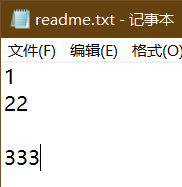- ubuntu12.04环境下使用kvm ioctl接口实现最简单的虚拟机
- Ubuntu 通过无线网络安装Ubuntu Server启动系统后连接无线网络的方法
- 在Ubuntu上搭建网桥的方法
- ubuntu 虚拟机上网方式及相关配置详解
CFSDN坚持开源创造价值,我们致力于搭建一个资源共享平台,让每一个IT人在这里找到属于你的精彩世界.
这篇CFSDN的博客文章关于python中readlines函数的参数hint的相关知识总结由作者收集整理,如果你对这篇文章有兴趣,记得点赞哟.
|
1
2
3
4
5
6
7
8
9
10
|
>>> fr
=
open
(
'readme.txt'
)
>>>
help
(fr.readlines)
help
on built
-
in
function readlines:
readlines(hint
=
-
1
,
/
) method of _io.textiowrapper instance
return
a
list
of lines
from
the stream.
hint can be specified to control the number of lines read: no more
lines will be read
if
the total size (
in
bytes
/
characters) of
all
lines so far exceeds hint.
|
_io.textiowrapper 实例的 readlines(hint=-1, /) 方法 从流中返回行列表。 可以指定 hint 来控制读取的行数:如果到目前为止所有行的总大小(以字节/字符为单位)超过hint,则不会读取更多行.

|
1
2
3
|
>>> f
=
open
(
'readme.txt'
)
>>> f.readlines()
[
'1\n'
,
'22\n'
,
'\n'
,
'333'
]
|
为了进一步搞清楚hint,我写了一个函数来演示 。
|
1
2
3
4
5
6
7
8
9
10
11
12
13
14
15
16
17
18
19
20
21
22
23
|
def
readlinesfile(filename,nbyte):
'''
探索f.readlines(i)中i的作用,典型的调用形式:
readlinesfile('readme.txt',12)
'''
for
i
in
range
(nbyte):
f
=
open
(filename)
ss
=
f.readlines(i)
if
i
=
=
0
:
#如果hint=0,先把每一个元素输出
textline
=
len
(ss)
#文件的总行数
ntotalbyte
=
0
#文件的总字数
nwritebyte
=
0
#已经写了的字节数
for
j
in
range
(textline):
#nwritebyte=ntotalbyte#已经写了的字节数
ntotalbyte
=
ntotalbyte
+
len
(ss[j])
rowbyte
=
0
#已经写了的新行的字节数,用来记一行已经输出的字节个数
while
nwritebyte<ntotalbyte:
#当已写字节<总字节数
print
(f
'{nwritebyte+1}:'
,
repr
(ss[j][rowbyte]))
#repr是为了输出换行符
nwritebyte
=
nwritebyte
+
1
rowbyte
=
rowbyte
+
1
print
(f
'行数={textline},字数={ntotalbyte}'
)
print
(f
'f.readlines{i}={ss}'
)
f.close()
|
输出 。
>>> readlinesfile('readme.txt',12) 1: '1' 2: '\n' 3: '2' 4: '2' 5: '\n' 6: '\n' 7: '3' 8: '3' 9: '3' 行数=4,字数=9 f.readlines0=['1\n', '22\n', '\n', '333'] f.readlines1=['1\n'] f.readlines2=['1\n', '22\n'] f.readlines3=['1\n', '22\n'] f.readlines4=['1\n', '22\n'] f.readlines5=['1\n', '22\n', '\n'] f.readlines6=['1\n', '22\n', '\n', '333'] f.readlines7=['1\n', '22\n', '\n', '333'] f.readlines8=['1\n', '22\n', '\n', '333'] f.readlines9=['1\n', '22\n', '\n', '333'] f.readlines10=['1\n', '22\n', '\n', '333'] f.readlines11=['1\n', '22\n', '\n', '333'] 。
1.hint 是要输出显示的字节数 。
2.hint 默认等于-1,就是以列表的形式读出所有内容 。
3.hint = 0时,效果等同于-1 。
4.hint 所指的字节数正好是换行符的话,则实际输出是 hint+1 。
更花哨的readlinesfile 。
|
1
2
3
4
5
6
7
8
9
10
11
12
13
14
15
16
17
18
19
20
21
22
23
24
25
26
27
28
29
30
31
|
def
readlinesfile(filename,nbyte):
'''
探索f.readlines(i)中i是指什么,典型的调用形式:
readlinesfile('readme.txt',12)
'''
specialbyte
=
[]
#存储特殊的字节数用
for
i
in
range
(nbyte):
with
open
(filename) as f:
#使用with语句就可以不使用f.close()了
ss
=
f.readlines(i)
if
(i
=
=
0
):
#如果hint=0,先把每一个元素输出
print
(ss)
textline
=
len
(ss)
#文件的总行数
ntotalbyte
=
0
#文件的总字数
nwritebyte
=
0
#已经写了的字节数
for
j
in
range
(textline):
#nwritebyte=ntotalbyte#已经写了的字节数
ntotalbyte
=
ntotalbyte
+
len
(ss[j])
rowbyte
=
0
#已经写了的新行的字节数,用来记一行已经输出的字节个数
while
nwritebyte<ntotalbyte:
#当已写字节<总字节数
if
(nwritebyte
is
ntotalbyte
-
1
):
specialbyte.append(nwritebyte)
print
(f
'\033[0;31;47m{nwritebyte+1:2d}:'
,
repr
(ss[j][rowbyte]),
'\033[0m'
)
#\033[0m是字体和背景颜色设置,注意可能需要其他库的支持
else
:
print
(f
'{nwritebyte+1:2d}:'
,
repr
(ss[j][rowbyte]))
nwritebyte
=
nwritebyte
+
1
rowbyte
=
rowbyte
+
1
print
(f
'\033[0;31;40m行数={textline:2d},字数={ntotalbyte:2d}\033[0m'
)
if
i
in
specialbyte:
print
(f
'\033[0;31;47mf.readlines{i:<2d}={ss}\033[0m'
)
#<是左对齐
else
:
print
(f
'f.readlines{i:<2d}={ss}'
)
#<是左对齐
|
效果 。

参考文章:http://www.zzvips.com/article/190944.html 。
到此这篇关于关于python中readlines函数的参数hint的相关知识总结的文章就介绍到这了,更多相关python readlines函数内容请搜索我以前的文章或继续浏览下面的相关文章希望大家以后多多支持我! 。
原文链接:https://blog.csdn.net/qq_35629563/article/details/117912503 。
最后此篇关于关于python中readlines函数的参数hint的相关知识总结的文章就讲到这里了,如果你想了解更多关于关于python中readlines函数的参数hint的相关知识总结的内容请搜索CFSDN的文章或继续浏览相关文章,希望大家以后支持我的博客! 。
简而言之:我想从可变参数模板参数中提取各种选项,但不仅通过标签而且通过那些参数的索引,这些参数是未知的 标签。我喜欢 boost 中的方法(例如 heap 或 lockfree 策略),但想让它与 S
我可以对单元格中的 excel IF 语句提供一些帮助吗? 它在做什么? 对“BaselineAmount”进行了哪些评估? =IF(BaselineAmount, (Variance/Baselin
我正在使用以下方法: public async Task Save(Foo foo,out int param) { ....... MySqlParameter prmparamID
我正在使用 CodeGear RAD Studio IDE。 为了使用命令行参数测试我的应用程序,我多次使用了“运行 -> 参数”菜单中的“参数”字段。 但是每次我给它提供一个新值时,它都无法从“下拉
我已经为信用卡类编写了一些代码,粘贴在下面。我有一个接受上述变量的构造函数,并且正在研究一些方法将这些变量格式化为字符串,以便最终输出将类似于 号码:1234 5678 9012 3456 截止日期:
MySql IN 参数 - 在存储过程中使用时,VarChar IN 参数 val 是否需要单引号? 我已经像平常一样创建了经典 ASP 代码,但我没有更新该列。 我需要引用 VarChar 参数吗?
给出了下面的开始,但似乎不知道如何完成它。本质上,如果我调用 myTest([one, Two, Three], 2); 它应该返回元素 third。必须使用for循环来找到我的解决方案。 funct
将 1113355579999 作为参数传递时,该值在函数内部变为 959050335。 调用(main.c): printf("%d\n", FindCommonDigit(111335557999
这个问题在这里已经有了答案: Is Java "pass-by-reference" or "pass-by-value"? (92 个回答) 关闭9年前。 public class StackOve
我真的很困惑,当像 1 == scanf("%lg", &entry) 交换为 scanf("%lg", &entry) == 1 没有区别。我的实验书上说的是前者,而我觉得后者是可以理解的。 1 =
我正在尝试使用调用 SetupDiGetDeviceRegistryProperty 的函数使用德尔福 7。该调用来自示例函数 SetupEnumAvailableComPorts .它看起来像这样:
我需要在现有项目上实现一些事件的显示。我无法更改数据库结构。 在我的 Controller 中,我(从 ajax 请求)传递了一个时间戳,并且我需要显示之前的 8 个事件。因此,如果时间戳是(转换后)
rails 新手。按照多态关联的教程,我遇到了这个以在create 和destroy 中设置@client。 @client = Client.find(params[:client_id] || p
通过将 VM 参数设置为 -Xmx1024m,我能够通过 Eclipse 运行 Java 程序-Xms256M。现在我想通过 Windows 中的 .bat 文件运行相同的 Java 程序 (jar)
我有一个 Delphi DLL,它在被 Delphi 应用程序调用时工作并导出声明为的方法: Procedure ProduceOutput(request,inputs:widestring; va
浏览完文档和示例后,我还没有弄清楚 schema.yaml 文件中的参数到底用在哪里。 在此处使用 AWS 代码示例:https://github.com/aws-samples/aws-proton
程序参数: procedure get_user_profile ( i_attuid in ras_user.attuid%type, i_data_group in data_g
我有一个字符串作为参数传递给我的存储过程。 dim AgentString as String = " 'test1', 'test2', 'test3' " 我想在 IN 中使用该参数声明。 AND
这个问题已经有答案了: When should I use "this" in a class? (17 个回答) 已关闭 6 年前。 我运行了一些java代码,我看到了一些我不太明白的东西。为什么下
我输入 scroll(0,10,200,10);但是当它运行时,它会传递字符串“xxpos”或“yypos”,我确实在没有撇号的情况下尝试过,但它就是行不通。 scroll = function(xp

我是一名优秀的程序员,十分优秀!